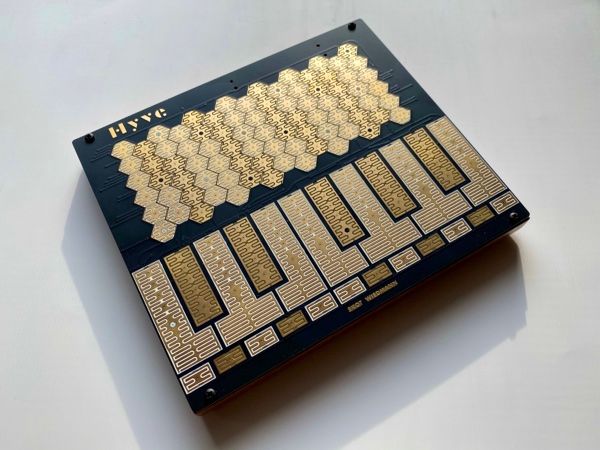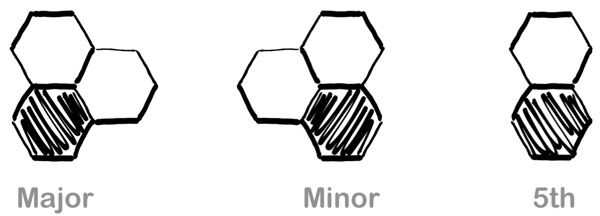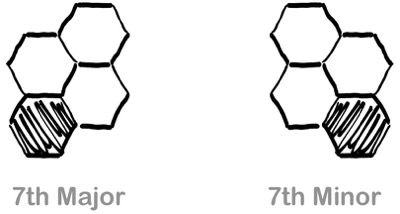How to play Hyve Touch Synth.

Keyboard players have a real disadvantage when they first lay their hands on Hyve. Sure, your keyboard knowledge is of great use, but your keyboard skills: well, throw them out the window. Not only are the “keys” on Hyve smaller than a standard keyboard and limited to 12 physical keys, each key plays five octaves of that note and pans in stereo depending on where you touch. Then there’s the Hyve grid above the keys that’s arranged to play chords with one of finger, but not in a chromatic layout. These aren’t criticisms of Hyve, just observations on its uniqueness. In ways, Hyve is so simple, someone with no musical knowledge may get the hang of it faster, since they don’t have years of keyboard training to unthink.
Playing areas is the key to Hyve’s keys.
Trying to touch the tiny spots on the 12 keys that represent octaves 3-6 is counterintuitive and may not be the best way to go about playing. Look at Hyve’s keys this way: Preciseness doesn’t really matter. Instead of playing with your fingertips, try playing with the pad of your fingers, the part between the tip and first knuckle. You’ll get two or three organ-like octaves, but this doesn’t matter, since the five notes on each key are the same, just an octave apart. To get a sound that’s an octave up or down, just tap a little higher or lower. This method feels much more natural.
Learning to play areas of the key, rather than precise notes, also lets you easily rock the pads up and down to add overtones and undertones mid-note.
Playing shapes helps you master Hyve’s grid.
While chromatic notes aren’t adjacent on the upper grid part of Hyve, chords are. The grid is designed for playing chords by touching two or three hexagons. If you think of playing shapes, you’ll find the grid makes much more sense. Learning the grid can seem intimidating, but the white dots on the C notes and the black dots on the F# notes give you good reference points, as do the light and dark accents on the grid.
The shapes.
The grid is arranged so there are three adjacent playing shapes: major, minor and 5th. The chart below shows the root note in black.

Play the major shape anywhere on the grid and you get a major chord. The standard I, IV, V chords in pop music are also simple: Tap any hexagon in the major shape for the root chord of I, one below it for IV (an octave below in pitch) and one above it for V. To add the VI minor chord an octave above, play the minor shape three hexagons above the root. Pop accompaniment just got amazingly simple.
Since the 5ths are stacked on top of each other, you can play more complex 5th chords by laying down a finger vertically on a stack. Try sliding the finger across the grid for a pattern of 5th chords.
To play 7th chords, just add the hexagon to the upper right of the chord, as pictured below. You can plays both major and minor 7ths.

And there’s no reason why a chord should be static: You can play arpeggios on Hyve by repeatedly drawing any shape with your finger.
Expression on Hyve.
Since your finger becomes a capacitor in Hyve’s circuitry it’s the ultimate human/synth interface. It gives you the most intimate expression available on an electronic instrument today. Once you’ve figured out the basics of notes, here’s how expression works on Hyve:
- Attack/Decay Tap Hyve firmly for a sharp attack. Gently touch and press for a slower attack. Pull off quickly or slowly lift to control decay. Most players start by playing Hyve like an organ with a sharp attack and decay, but learning soft and hard presses and a slow touch or release will greatly expand the sounds you can create.
- Sustain Hyve makes sustain seem liquid rather than fixed, like on most synths. Since Hyve is effectively pressure sensitive, you can gently change pressure on you fingers individually and it subtly changes volume, giving you very precise envelope control. No longer are you restricted to the regimented envelope curves.
- Volume To get more volume and a larger dynamic range out of Hyve, rub a little motion on your fingers.
- Tremolo/Pan Hyve’s contol over placement of the sounds within the stereo field adds another dimension to your playing. When playing a note on the keys, tilt your finger left or right to place the note in the stereo field. Rock your finger back a forth for a stereo tremolo. On the Hyve grid, press a shape lightly and the notes start in a soft stereo split. As you press harder they get louder and merge together in the center.
- Pitch Bend Hyve’s pitch bend is somewhat awkwardly placed. (It would more ergonomically be positioned above the keys.) Still, touching, wiggling, tapping etc. will give you some useful bends, tweedles and vibrato that can take on the characteristics of pulse-width modulation. Try playing a chord on the Hyve and bending just one of the notes in it. (It has the most obvious effect when the root is bent and very subtle effects when the 2nd and 3rd notes of the chord are bent.
All these nuances can take a while to master, but once learned, they can really enhance your musical expression.
My take.
While Hyve makes the complexities of music easy, playing can be even simpler than that. Tap or slide up and down or back and forth across the grid and keys with the pad of one finger and you really can’t play a wrong note or wrong chord. But since Hyve is ripe for ambient and experimental music, forget about being an artist like Bach and think more in terms of being an artist like Jackson Pollack: Ditch convention and try moving randomly with multiple fingers or even use the palm of your hand. You can even play drones by blowing with a straw on the circuitboard. So much can be accomplished with the tiny 5" by 6" device, you’ll be amazed at what you can come up with when you unthink music entirely.
